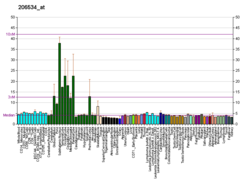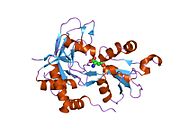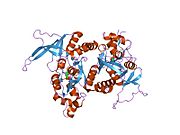Glutamate receptor subunit epsilon-1 is a protein that in humans is encoded by the GRIN2A gene. With 1464 amino acids, the canonical GluN2A subunit isoform is large. GluN2A-short isoforms specific to primates can be produced by alternative splicing and contain 1281 amino acids.
Function
N-methyl-D-aspartate (NMDA) receptors are a class of ionotropic glutamate receptors. NMDA channel has been shown to be involved in long-term potentiation, an activity-dependent increase in the efficiency of synaptic transmission thought to underlie certain kinds of memory and learning. NMDA receptor channels are heteromers composed of the key receptor subunit NMDAR1 (GRIN1) and 1 or more of the 4 NMDAR2 subunits: NMDAR2A (GRIN2A), NMDAR2B (GRIN2B), NMDAR2C (GRIN2C), and NMDAR2D (GRIN2D).
Associations
Variants of the gene are associated with the protective effect of coffee on Parkinson's disease.
Mutations in GRIN2A are associated to refractory epilepsy.
Whole exome/genome sequencing has led to the discovery of an association between mutations in GRIN2A and a wide variety of neurological diseases, including epilepsy, intellectual disability, autism spectrum disorders, developmental delay, and schizophrenia.
Interactions
GRIN2A has been shown to interact with:
See also
References
- ^ GRCh38: Ensembl release 89: ENSG00000183454 – Ensembl, May 2017
- ^ GRCm38: Ensembl release 89: ENSMUSG00000059003 – Ensembl, May 2017
- "Human PubMed Reference:". National Center for Biotechnology Information, U.S. National Library of Medicine.
- "Mouse PubMed Reference:". National Center for Biotechnology Information, U.S. National Library of Medicine.
- Kalsi G, Whiting P, Bourdelles BL, Callen D, Barnard EA, Gurling H (February 1998). "Localization of the human NMDAR2D receptor subunit gene (GRIN2D) to 19q13.1-qter, the NMDAR2A subunit gene to 16p13.2 (GRIN2A), and the NMDAR2C subunit gene (GRIN2C) to 17q24-q25 using somatic cell hybrid and radiation hybrid mapping panels". Genomics. 47 (3): 423–425. doi:10.1006/geno.1997.5132. PMID 9480759.
- Warming H, Pegasiou CM, Pitera AP, Kariis H, Houghton SD, Kurbatskaya K, et al. (July 2019). "A primate-specific short GluN2A-NMDA receptor isoform is expressed in the human brain". Molecular Brain. 12 (1): 64. doi:10.1186/s13041-019-0485-9. PMC 6610962. PMID 31272478.
- Herbrechter R, Hube N, Buchholz R, Reiner A (July 2021). "Splicing and editing of ionotropic glutamate receptors: a comprehensive analysis based on human RNA-Seq data". Cellular and Molecular Life Sciences. 78 (14): 5605–5630. doi:10.1007/s00018-021-03865-z. PMC 8257547. PMID 34100982.
- "Entrez Gene: GRIN2A glutamate receptor, ionotropic, N-methyl D-aspartate 2A".
- Hamza TH, Chen H, Hill-Burns EM, Rhodes SL, Montimurro J, Kay DM, et al. (August 2011). "Genome-wide gene-environment study identifies glutamate receptor gene GRIN2A as a Parkinson's disease modifier gene via interaction with coffee". PLOS Genetics. 7 (8): e1002237. doi:10.1371/journal.pgen.1002237. PMC 3158052. PMID 21876681.
- Yamada-Fowler N, Fredrikson M, Söderkvist P (June 2014). "Caffeine interaction with glutamate receptor gene GRIN2A: Parkinson's disease in Swedish population". PLOS ONE. 9 (6): e99294. Bibcode:2014PLoSO...999294Y. doi:10.1371/journal.pone.0099294. PMC 4051678. PMID 24915238.
- Venkateswaran S, Myers KA, Smith AC, Beaulieu CL, Schwartzentruber JA, Majewski J, et al. (July 2014). "Whole-exome sequencing in an individual with severe global developmental delay and intractable epilepsy identifies a novel, de novo GRIN2A mutation". Epilepsia. 55 (7): e75 – e79. doi:10.1111/epi.12663. PMID 24903190. S2CID 205116246.
- Yuan H, Low CM, Moody OA, Jenkins A, Traynelis SF (July 2015). "Ionotropic GABA and Glutamate Receptor Mutations and Human Neurologic Diseases". Molecular Pharmacology. 88 (1): 203–217. doi:10.1124/mol.115.097998. PMC 4468639. PMID 25904555.
- Gardoni F, Mauceri D, Fiorentini C, Bellone C, Missale C, Cattabeni F, Di Luca M (November 2003). "CaMKII-dependent phosphorylation regulates SAP97/NR2A interaction". The Journal of Biological Chemistry. 278 (45): 44745–44752. doi:10.1074/jbc.M303576200. PMID 12933808.
- ^ Irie M, Hata Y, Takeuchi M, Ichtchenko K, Toyoda A, Hirao K, et al. (September 1997). "Binding of neuroligins to PSD-95". Science. 277 (5331): 1511–1515. doi:10.1126/science.277.5331.1511. PMID 9278515.
- ^ Lim IA, Hall DD, Hell JW (June 2002). "Selectivity and promiscuity of the first and second PDZ domains of PSD-95 and synapse-associated protein 102". The Journal of Biological Chemistry. 277 (24): 21697–21711. doi:10.1074/jbc.M112339200. PMID 11937501.
- ^ Hou XY, Zhang GY, Yan JZ, Chen M, Liu Y (November 2002). "Activation of NMDA receptors and L-type voltage-gated calcium channels mediates enhanced formation of Fyn-PSD95-NR2A complex after transient brain ischemia". Brain Research. 955 (1–2): 123–132. doi:10.1016/s0006-8993(02)03376-0. PMID 12419528. S2CID 85751.
- Satoh K, Yanai H, Senda T, Kohu K, Nakamura T, Okumura N, et al. (June 1997). "DAP-1, a novel protein that interacts with the guanylate kinase-like domains of hDLG and PSD-95". Genes to Cells. 2 (6): 415–424. doi:10.1046/j.1365-2443.1997.1310329.x. PMID 9286858. S2CID 8934092.
- Sans N, Petralia RS, Wang YX, Blahos J, Hell JW, Wenthold RJ (February 2000). "A developmental change in NMDA receptor-associated proteins at hippocampal synapses". The Journal of Neuroscience. 20 (3): 1260–1271. doi:10.1523/JNEUROSCI.20-03-01260.2000. PMC 6774158. PMID 10648730.
- ^ Ma J, Zhang GY (September 2003). "Lithium reduced N-methyl-D-aspartate receptor subunit 2A tyrosine phosphorylation and its interactions with Src and Fyn mediated by PSD-95 in rat hippocampus following cerebral ischemia". Neuroscience Letters. 348 (3): 185–189. doi:10.1016/s0304-3940(03)00784-5. PMID 12932824. S2CID 40684016.
- Tezuka T, Umemori H, Akiyama T, Nakanishi S, Yamamoto T (January 1999). "PSD-95 promotes Fyn-mediated tyrosine phosphorylation of the N-methyl-D-aspartate receptor subunit NR2A". Proceedings of the National Academy of Sciences of the United States of America. 96 (2): 435–440. Bibcode:1999PNAS...96..435T. doi:10.1073/pnas.96.2.435. PMC 15154. PMID 9892651.
- ^ Takagi N, Cheung HH, Bissoon N, Teves L, Wallace MC, Gurd JW (August 1999). "The effect of transient global ischemia on the interaction of Src and Fyn with the N-methyl-D-aspartate receptor and postsynaptic densities: possible involvement of Src homology 2 domains". Journal of Cerebral Blood Flow and Metabolism. 19 (8): 880–888. doi:10.1097/00004647-199908000-00007. PMID 10458595.
- Kurschner C, Yuzaki M (September 1999). "Neuronal interleukin-16 (NIL-16): a dual function PDZ domain protein". The Journal of Neuroscience. 19 (18): 7770–7780. doi:10.1523/JNEUROSCI.19-18-07770.1999. PMC 6782450. PMID 10479680.
- Seabold GK, Burette A, Lim IA, Weinberg RJ, Hell JW (April 2003). "Interaction of the tyrosine kinase Pyk2 with the N-methyl-D-aspartate receptor complex via the Src homology 3 domains of PSD-95 and SAP102". The Journal of Biological Chemistry. 278 (17): 15040–15048. doi:10.1074/jbc.M212825200. PMID 12576483.
- Liu Y, Zhang G, Gao C, Hou X (August 2001). "NMDA receptor activation results in tyrosine phosphorylation of NMDA receptor subunit 2A(NR2A) and interaction of Pyk2 and Src with NR2A after transient cerebral ischemia and reperfusion". Brain Research. 909 (1–2): 51–58. doi:10.1016/s0006-8993(01)02619-1. PMID 11478920. S2CID 21062909.
Further reading
- Schröder HC, Perovic S, Kavsan V, Ushijima H, Müller WE (1998). "Mechanisms of prionSc- and HIV-1 gp120 induced neuronal cell death". Neurotoxicology. 19 (4–5): 683–688. PMID 9745929.
- King JE, Eugenin EA, Buckner CM, Berman JW (April 2006). "HIV tat and neurotoxicity". Microbes and Infection. 8 (5): 1347–1357. doi:10.1016/j.micinf.2005.11.014. PMID 16697675.
- Monyer H, Sprengel R, Schoepfer R, Herb A, Higuchi M, Lomeli H, et al. (May 1992). "Heteromeric NMDA receptors: molecular and functional distinction of subtypes". Science. 256 (5060): 1217–1221. Bibcode:1992Sci...256.1217M. doi:10.1126/science.256.5060.1217. PMID 1350383. S2CID 989677.
- Kornau HC, Schenker LT, Kennedy MB, Seeburg PH (September 1995). "Domain interaction between NMDA receptor subunits and the postsynaptic density protein PSD-95". Science. 269 (5231): 1737–1740. Bibcode:1995Sci...269.1737K. doi:10.1126/science.7569905. PMID 7569905.
- Magnuson DS, Knudsen BE, Geiger JD, Brownstone RM, Nath A (March 1995). "Human immunodeficiency virus type 1 tat activates non-N-methyl-D-aspartate excitatory amino acid receptors and causes neurotoxicity". Annals of Neurology. 37 (3): 373–380. doi:10.1002/ana.410370314. PMID 7695237. S2CID 24405132.
- Sakimura K, Kutsuwada T, Ito I, Manabe T, Takayama C, Kushiya E, et al. (January 1995). "Reduced hippocampal LTP and spatial learning in mice lacking NMDA receptor epsilon 1 subunit". Nature. 373 (6510): 151–155. doi:10.1038/373151a0. PMID 7816096. S2CID 4356780.
- Foldes RL, Adams SL, Fantaske RP, Kamboj RK (August 1994). "Human N-methyl-D-aspartate receptor modulatory subunit hNR2A: cloning and sequencing of the cDNA and primary structure of the protein". Biochimica et Biophysica Acta (BBA) - Molecular Cell Research. 1223 (1): 155–159. doi:10.1016/0167-4889(94)90086-8. PMID 8061049.
- Sheng M, Cummings J, Roldan LA, Jan YN, Jan LY (March 1994). "Changing subunit composition of heteromeric NMDA receptors during development of rat cortex". Nature. 368 (6467): 144–147. Bibcode:1994Natur.368..144S. doi:10.1038/368144a0. PMID 8139656. S2CID 4332025.
- Roche KW, Raymond LA, Blackstone C, Huganir RL (April 1994). "Transmembrane topology of the glutamate receptor subunit GluR6". The Journal of Biological Chemistry. 269 (16): 11679–11682. doi:10.1016/S0021-9258(17)32623-6. PMID 8163463.
- Takano H, Onodera O, Tanaka H, Mori H, Sakimura K, Hori T, et al. (December 1993). "Chromosomal localization of the epsilon 1, epsilon 3 and zeta 1 subunit genes of the human NMDA receptor channel". Biochemical and Biophysical Research Communications. 197 (2): 922–926. doi:10.1006/bbrc.1993.2567. PMID 8267632.
- Lannuzel A, Lledo PM, Lamghitnia HO, Vincent JD, Tardieu M (November 1995). "HIV-1 envelope proteins gp120 and gp160 potentiate NMDA-induced i increase, alter i homeostasis and induce neurotoxicity in human embryonic neurons". The European Journal of Neuroscience. 7 (11): 2285–2293. doi:10.1111/j.1460-9568.1995.tb00649.x. PMID 8563977. S2CID 27201873.
- Corasaniti MT, Melino G, Navarra M, Garaci E, Finazzi-Agrò A, Nisticò G (September 1995). "Death of cultured human neuroblastoma cells induced by HIV-1 gp120 is prevented by NMDA receptor antagonists and inhibitors of nitric oxide and cyclooxygenase". Neurodegeneration. 4 (3): 315–321. doi:10.1016/1055-8330(95)90021-7. PMID 8581564.
- Niethammer M, Kim E, Sheng M (April 1996). "Interaction between the C terminus of NMDA receptor subunits and multiple members of the PSD-95 family of membrane-associated guanylate kinases". The Journal of Neuroscience. 16 (7): 2157–2163. doi:10.1523/JNEUROSCI.16-07-02157.1996. PMC 6578538. PMID 8601796.
- Pittaluga A, Pattarini R, Severi P, Raiteri M (May 1996). "Human brain N-methyl-D-aspartate receptors regulating noradrenaline release are positively modulated by HIV-1 coat protein gp120". AIDS. 10 (5): 463–468. doi:10.1097/00002030-199605000-00003. PMID 8724036. S2CID 1669986.
- Hess SD, Daggett LP, Crona J, Deal C, Lu CC, Urrutia A, et al. (August 1996). "Cloning and functional characterization of human heteromeric N-methyl-D-aspartate receptors". The Journal of Pharmacology and Experimental Therapeutics. 278 (2): 808–816. PMID 8768735.
- Wu P, Price P, Du B, Hatch WC, Terwilliger EF (April 1996). "Direct cytotoxicity of HIV-1 envelope protein gp120 on human NT neurons". NeuroReport. 7 (5): 1045–1049. doi:10.1097/00001756-199604100-00018. PMID 8804048. S2CID 21018147.
- Bennett BA, Rusyniak DE, Hollingsworth CK (December 1995). "HIV-1 gp120-induced neurotoxicity to midbrain dopamine cultures". Brain Research. 705 (1–2): 168–176. doi:10.1016/0006-8993(95)01166-8. PMID 8821747. S2CID 32822686.
- Toggas SM, Masliah E, Mucke L (January 1996). "Prevention of HIV-1 gp120-induced neuronal damage in the central nervous system of transgenic mice by the NMDA receptor antagonist memantine". Brain Research. 706 (2): 303–307. doi:10.1016/0006-8993(95)01197-8. PMID 8822372. S2CID 44260060.
- Dreyer EB, Lipton SA (December 1995). "The coat protein gp120 of HIV-1 inhibits astrocyte uptake of excitatory amino acids via macrophage arachidonic acid". The European Journal of Neuroscience. 7 (12): 2502–2507. doi:10.1111/j.1460-9568.1995.tb01048.x. PMID 8845955. S2CID 7370984.
- Raber J, Toggas SM, Lee S, Bloom FE, Epstein CJ, Mucke L (December 1996). "Central nervous system expression of HIV-1 Gp120 activates the hypothalamic-pituitary-adrenal axis: evidence for involvement of NMDA receptors and nitric oxide synthase". Virology. 226 (2): 362–373. doi:10.1006/viro.1996.0664. PMID 8955056.
| PDB gallery | |
|---|---|
| Ion channel, cell surface receptor: ligand-gated ion channels | |||||||||||
|---|---|---|---|---|---|---|---|---|---|---|---|
| Cys-loop receptors |
| ||||||||||
| Ionotropic glutamates |
| ||||||||||
| ATP-gated channels |
| ||||||||||
This article incorporates text from the United States National Library of Medicine, which is in the public domain.
Categories:






